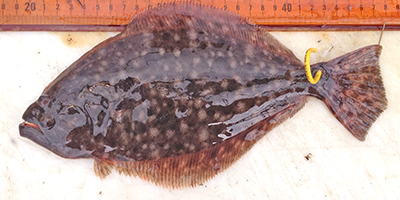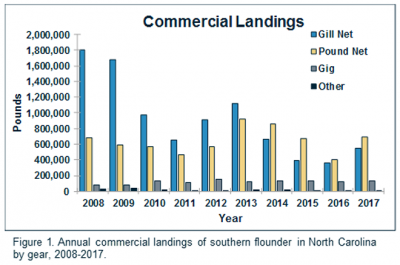From an Island Free Press report
This story has been updated.
Supporter Spotlight
RALEIGH — The state Marine Fisheries Commission in a split vote Friday gave final approval to controversial changes to the management plan for southern flounder, one of the state’s largest and most valuable fisheries, using commercial and recreational season closures and other measures in an effort to end overfishing and rebuild stocks.
The action came during the commission’s meeting at the Doubletree by Hilton University Brownstone in Raleigh.

With the commission’s 6-3 approval of the Southern Flounder Fishery Management Plan Amendment 2, officials with the Division of Marine Fisheries anticipate issuing a proclamation this week that closes the commercial and recreational season for southern flounder around Sept. 4.
The management plan calls for science-based measures to achieve sustainable harvest in the southern flounder fishery by ending overfishing by 2021 and rebuilding the spawning stock by 2028.
As adopted, the plan, which the division proposed earlier this year, gives the division director flexibility with the commercial and recreational seasons so long as they meet statutorily required southern flounder harvest reductions. State law mandates a minimum 52% reduction in North Carolina this year, compared to 2017 numbers, but the goal is 72%, said Patricia Smith, spokesperson for the division.
Supporter Spotlight
“We want to do more than the bare minimum, this is a stock that we’re concerned about,” Smith told Coastal Review Online Monday.
Southern flounder is one of three main species of flounder landed on the North Carolina coast, along with summer flounder and Gulf flounder. Smith said the action is about allowing enough fish to live, especially spawning fish, in order to reproduce enough to continue the fishery, which has been in decline for two decades.
Southern flounder landings totaled 1.39 million pounds with a dockside value of $5.66 million in 2017, according to the Division of Marine Fisheries. But after steady increases in southern flounder landings from the mid-1970s through the 1990s, when it peaked at more than 4 million pounds, landings steadily declined to about 1.4 million pounds in 2017.

Since 2011, recreational harvests of southern flounder have declined in part because of increases in the minimum size limits, according to the draft published in June.
The final vote to adopt Amendment 2 came Friday during the commission’s three-day meeting in Raleigh along with three additional amendments to the proposed draft that were approved in separate votes, including an amendment unanimously approved to allow for seasonal flexibility for both commercial and recreational fishers.
Another amendment to ask the director to allow for-hire charter boat captains to possess up to four flounders per vessel per day outside of the recreational season, or May 1 through Nov. 1, was also approved in a 5-2 vote with two commissioners abstaining. But Smith with the division said Tuesday the decision was up to the director and “not something that is necessarily going to happen.”
An additional motion to ask the Division of Marine Fisheries director to consider exceptions to the 15A section of the amendment, which requires existing flounder pound net sets to be actively fished during the relevant period, passed with seven commissioners in favor and two abstentions.
The measures approved Friday also call for yardage and time restrictions for gill nets, and prohibiting the use of puncturing devices, such as gaffs, in the pound net fishery.
‘Fast-tracked’
Those who opposed Amendment 2 noted during the meeting Friday the rushed nature of the measure, the need for cooperation from other states for the measure to be a success and the potential hardship for fishing interests.
“When we put this thing into motion, the biggest issues I had are basically how it got fast-tracked,” said Commissioner Doug Cross. “We didn’t have time to present or gather other options to include in the division’s recommendation … As we move forward, that’s a huge concern.
“The largest loser in this is our user groups,” continued Cross. “I think there is a huge misunderstanding in the general public … of how this is going to be regulated.
He said there should be more consideration of how commercial and recreational fishers would be affected and called for ways to lessen the burden.

“I wish we had coordinated a little more on management options that made more sense, because this just doesn’t make any sense to me,” said Commissioner Mike Blanton. “I had many conversations, both recreational and commercial, and I don’t see many people (agreeing) with this.”
Blanton also pointed out that North Carolina would be the first of the coastal states to implement such a measure, and other states’ cooperation would be required to make any sort of impact on the southern flounder supply.
“This is null and void unless these other states start at the same time that we do,” he said. “Right now, we have a single state regulatory measure. We’re trying to take care of our stock and hoping other states will jump on board because of this action.”
Commissioner Sam Romano asked Division of Marine Fisheries Director Stephen Murphey about the participation of other coastal states. “How are they feeling about what we are doing here?”

“I think they are waiting to hear what happens today,” said Murphey. “(We) have a meeting next week, and we have asked them to come to the table. I think they want to see what you guys are going to do. We are the only state that has a mandatory requirement to take action when (there is) overfishing.”
Prior to the vote on Draft Amendment 2, Commissioner Doug Cross made a failed motion to postpone the final approval vote to the commission’s meeting set for November, adopt a 52% reduction at that time and to instruct the director to consult with other states. Although seconded by Commissioner Sam Romano the motion failed 3-6.
Dare County Commissioner and Working Watermen Committee Chair Steve House, who attended the meeting on Wednesday and Thursday, told Island Free Press Friday that he was disappointed in the outcome but heartened by the commissioners’ concern over the economic burden on those who depend on the fishery. He said North Carolina cannot replenish stocks alone, other states must commit as well.
“I believe after talking with Director Steve Murphey and some commissioners, the economic aspects of our community in fishing will be looked at in more depth in the future,” he said.
The commission had voted in June to accept the division’s recommendations in their entirety as the preferred management options for Draft Amendment 2. The management measures approved Friday are to remain until a third amendment can be developed, which is expected sometime in 2021.
“As research has now begun for Amendment 3, we need to work with the NCDMF to be more proactive in the process and not reactive,” House said.







